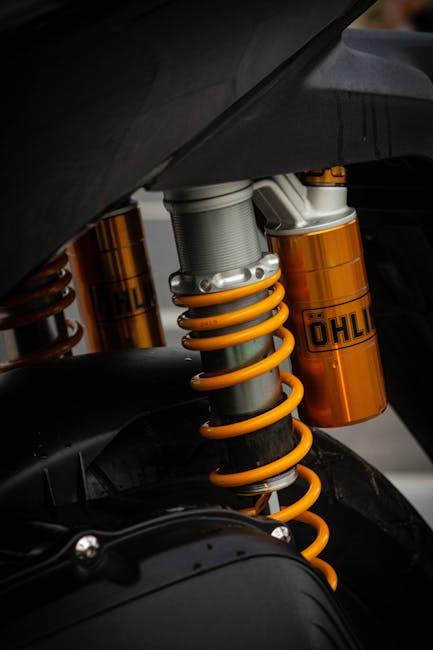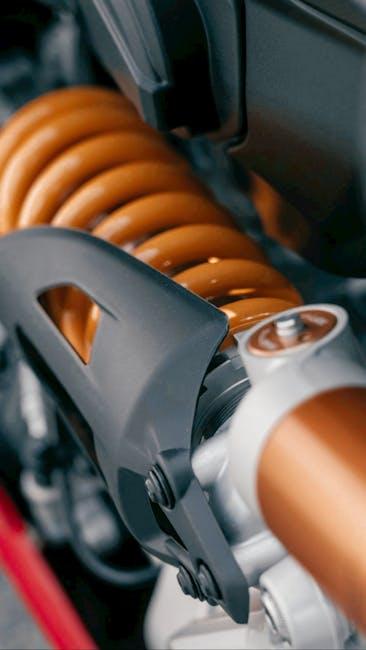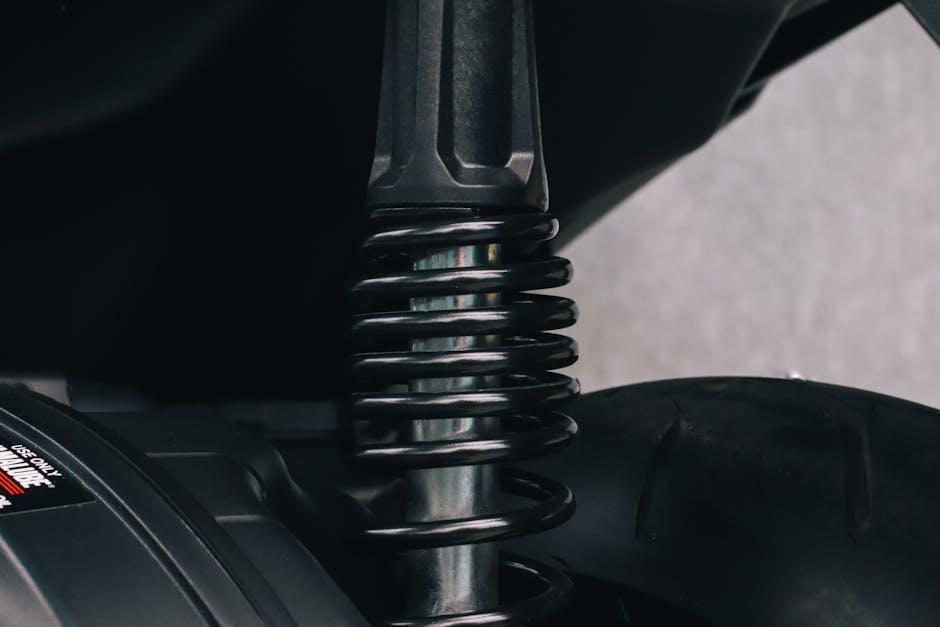When it comes to vehicle maintenance, few components play a role as quietly crucial as your shock absorbers. These unsung heroes absorb the bumps and jolts of the road, ensuring a smooth and safe ride. But when one shock starts to falter, an important question arises: should you replace just that one, or overhaul all four at once? The answer isn’t always straightforward. In this article, we’ll explore the considerations behind replacing shocks individually versus as a complete set, helping you make an informed decision that balances performance, safety, and budget.
Table of Contents
- Evaluating the Condition of Your Current Shocks
- The Impact of Uneven Shock Absorber Performance
- Cost Considerations When Replacing Shocks
- Safety and Handling Benefits of Replacing All Shocks Together
- Expert Guidelines for Choosing the Right Time to Replace Shocks
- Balancing Longevity and Budget in Shock Replacement Decisions
- Q&A
- Insights and Conclusions

Evaluating the Condition of Your Current Shocks
Start by giving your shocks a close inspection to determine their health. Look for signs such as leaking fluid, unusual noises like clunking or squeaking, and uneven tire wear—these often indicate worn-out shocks. Additionally, perform a simple bounce test by pressing down on each corner of your car; if it continues to bounce more than twice, the shocks may be compromised. Keep in mind that age and mileage are crucial factors too, as shocks typically have a lifespan of 50,000 to 100,000 miles depending on driving conditions.
It’s helpful to keep track of symptom patterns by checking how your car responds under different conditions. For example, monitor stability while cornering, braking, or driving over bumps. To make your evaluation clearer, here’s a quick reference chart outlining typical shock absorber conditions:
| Symptom | Likely Condition | Recommended Action |
|---|---|---|
| Visible fluid leaks | Damaged seals | Replace immediately |
| Excessive bouncing | Reduced damping | Consider replacement |
| Unusual noises | Loose or worn parts | Inspect and possibly replace |
| Tire wear irregularities | Imbalanced shocks | Check suspension and replace affected shocks |

The Impact of Uneven Shock Absorber Performance
When shock absorbers perform unevenly, the ride quality and vehicle stability can deteriorate rapidly, leading to a host of safety concerns. Uneven shock absorption causes inconsistent handling, especially during cornering or sudden braking, which increases the risk of losing control. Drivers may experience excessive bouncing on one side, resulting in uneven tire wear and compromised traction. This imbalance can also place undue stress on suspension components, accelerating wear and potentially leading to costly repairs.
Some notable consequences of uneven shock absorber performance include:
- Reduced braking efficiency and longer stopping distances
- Increased body roll and sway during turns
- Uneven tire wear patterns, decreasing tire lifespan
- Potential alignment issues causing steering problems
| Symptom | Cause | Impact |
|---|---|---|
| Uneven Vehicle Bounce | One worn shock absorber | Poor ride comfort & control |
| Unequal Tire Wear | Imbalanced shock damping | Increased replacement costs |
| Steering Pull | Asymmetrical suspension response | Driver fatigue & safety risk |

Cost Considerations When Replacing Shocks
When considering new shocks, budget plays a pivotal role in decision-making. Shock absorbers vary widely in price depending on the brand, quality, and technology used. Opting to replace all four shocks at once may seem costly upfront, but it often proves more economical in the long run by avoiding repeated labor charges and ensuring uniformly balanced suspension performance. Before committing, it’s wise to factor in additional expenses such as wheel alignment and potential suspension component inspections to prevent hidden repair costs.
It’s helpful to break down typical costs to make an informed choice:
| Item | Average Cost (USD) |
|---|---|
| Single Shock Absorber | $50 – $150 |
| Complete Set (4 shocks) | $200 – $600 |
| Labor | $100 – $200 per axle |
| Wheel Alignment | $75 – $150 |
- Cost savings: Bulk replacement reduces repeated shop visits.
- Performance balance: New shocks ensure consistent handling and ride comfort.
- Long-term durability: Avoid uneven wear from mismatched shock ages.

Safety and Handling Benefits of Replacing All Shocks Together
Replacing all shocks simultaneously ensures your vehicle maintains balanced suspension performance, which directly translates to safer handling on the road. When shocks are mismatched—some new, some worn—the vehicle can experience uneven weight distribution, reduced traction, and compromised stability during turns or sudden stops. This imbalance increases the risk of skidding or losing control, especially in adverse weather or emergency maneuvers. Consistent shock absorbers work in harmony to keep your tires firmly planted, improving braking efficiency and steering response.
Beyond stability, changing all shocks together reduces strain on other suspension components, promoting overall vehicle longevity. It also provides predictable and uniform damping, which smooths out road irregularities evenly, minimizing wear on tires and improving ride comfort. Consider these key benefits:
- Enhanced vehicle control for safer driving conditions
- Reduced risk of premature tire wear and suspension damage
- Improved braking distances and road grip
- Smoother, more comfortable rides for all passengers

Expert Guidelines for Choosing the Right Time to Replace Shocks
Determining when to replace your vehicle’s shocks can significantly impact both safety and ride quality. Experts typically recommend inspecting shocks every 50,000 miles, but signs like uneven tire wear, excessive bouncing, or longer stopping distances should urge you to consider replacement sooner. If one shock shows severe wear or damage, it’s often wise not to delay replacing its counterparts to maintain balanced handling and stability.
To simplify decision-making, here’s a quick comparison of factors that signal replacement for single vs. complete shock swaps:
| Factor | Replace One Shock | Replace All Shocks |
|---|---|---|
| Age of Shocks | One or two aged shocks showing damage | All shocks nearing or exceeding 75,000 miles |
| Performance | Isolated bounce or noise complaints | Noticeable overall decline in ride comfort and control |
| Cost Efficiency | Lower immediate expense | Long-term savings from uniform wear and reduced labor costs |
| Safety & Handling | Slight imbalance in vehicle stability | Optimal balance and consistent handling performance |
Ultimately, while replacing all shocks simultaneously may seem costlier upfront, it ensures consistent wear rates across your vehicle and enhances safety. Consider your driving habits, vehicle usage, and expert advice to decide the best approach for your needs.

Balancing Longevity and Budget in Shock Replacement Decisions
When deciding how to approach replacing your vehicle’s shocks, it’s essential to strike a balance between durability and cost. Investing in high-quality shocks may mean a higher upfront expense, but these components typically last longer and improve vehicle safety and comfort. Conversely, opting for budget-friendly options can ease immediate financial strain but might necessitate more frequent replacements and repairs, leading to bigger costs down the road. Evaluating your driving habits and the typical terrain you encounter can guide you in weighing these factors thoughtfully.
Consider the following points to help make an informed decision:
- Driving Frequency: Frequent or long-distance drivers benefit more from premium shocks that endure wear and tear.
- Road Conditions: Rough or uneven terrains demand more robust shocks to maintain performance and safety.
- Vehicle Age and Make: Some models require specific shocks that balance well with the vehicle’s weight and suspension system.
- Budget Constraints: Prioritize shocks that fit your financial plan without compromising essential quality.
| Shock Type | Average Lifespan | Estimated Cost | Best For |
|---|---|---|---|
| Standard | 50,000 miles | $100 – $150 each | Light city driving |
| Premium | 80,000+ miles | $180 – $250 each | Heavy use, rough terrain |
| Budget | 30,000 miles | $50 – $80 each | Occasional use, tight budgets |
Q&A
Q:
A: While it’s not strictly necessary to replace all shocks simultaneously, it’s often recommended. Shocks work together to maintain vehicle stability and ride comfort. Installing new shocks on just one axle can lead to uneven handling, uneven tire wear, and a less balanced driving experience. Replacing all shocks at once ensures consistent performance and safety, helping your vehicle respond predictably on the road.
Q: What are the risks of replacing only some of the shocks?
A: Mixing old and new shocks can create imbalance. The newer shocks will absorb bumps more effectively, while the worn ones struggle, causing uneven suspension response. This mismatch can lead to decreased traction and control, especially during cornering or emergency maneuvers. Over time, it may also cause premature wear on other suspension components.
Q: Are there situations when replacing just two shocks is acceptable?
A: Yes, if one axle’s shocks are significantly worn while the other axle’s shocks remain in good condition, replacing only the worn pair can be a practical choice. Often, the rear shocks wear faster than the front, or vice versa, depending on driving habits and vehicle load. However, it’s crucial that the shocks you keep still have adequate life left to maintain balanced handling.
Q: How do I know when it’s time to replace my shocks?
A: Signs include a rougher ride, excessive bouncing after hitting a bump, nose-diving when braking, uneven tire wear, or fluid leaks from the shock absorber itself. If one shock is clearly damaged or worn, it’s wise to inspect all shocks and consider replacement for consistent performance.
Q: What are the benefits of replacing all shocks at once?
A: New shocks across the vehicle restore ride comfort, stability, and safety uniformly. The suspension system performs as designed, improving braking, cornering, and overall handling. This approach can also save labor costs in the long run, since shocks often wear out around the same time.
Q: Does vehicle type affect the decision to replace shocks all at once?
A: Absolutely. For trucks and SUVs used in heavy-duty or off-road conditions, shock wear can be uneven due to load distribution. In such cases, replacing all shocks simultaneously can be more critical to maintain control. For lighter passenger cars, the need might be less urgent but still advisable for balanced driving dynamics.
Q: Can I replace shocks in pairs instead of all four?
A: Replacing shocks in pairs (both front or both rear) is a common middle ground. This maintains symmetry on either axle, helping preserve handling balance while managing costs. Just ensure the other pair is still in good shape.
Q: Bottom line—should you replace all shocks at once?
A: For optimal performance, safety, and ride quality, yes, replacing all shocks at once is best. However, depending on your vehicle’s condition and usage, replacing them in pairs can be acceptable. Always consult a trusted mechanic to evaluate your suspension and make the best recommendation for your situation.
Insights and Conclusions
In the end, whether you decide to replace all your shocks at once or tackle them one by one depends on your budget, driving habits, and the condition of each component. While a full set promises balanced performance and peace of mind, sometimes a targeted approach can be just as effective. Whatever path you choose, keeping your suspension in good shape ensures a smoother, safer ride—because every journey deserves to feel just right.
